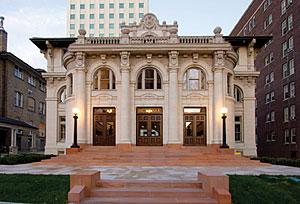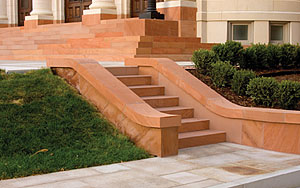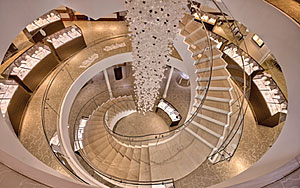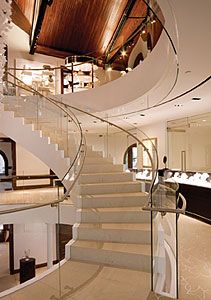
A range of stone materials were utilized for the
historic restoration/renovation project that would become O.C. Tanner Flagship
Jewelry Store in Salt Lake City,
UT. At the building’s east
elevation, a brick exterior was replaced with large 1,800-pound honed slabs of
Valders Buff limestone from Valders Stone & Marble, Inc. in Valders, WI,
which surround a glass curtainwall.
Valders Buff limestone from Valders Stone & Marble, Inc. in Valders, WI, was able to naturally replicate the stone color of an historic building in Salt Lake City, UT. Fabricated stone had to match different finish requirements for the exterior of a restoration project that would become O.C. Tanner Flagship Jewelry Store. Additionally, the company’s Valders Dovewhite dolomitic limestone was used for the interior redesign.
Originally built in 1906 as a city library, the building added a brick addition in 1961, when it was converted into a planetarium. In 2003, the planetarium relocated, and the building - listed on the National Register of Historic Places - was left vacant. O.C. Tanner Company, a multi-million dollar company known for making jewelry as well as awards for the Olympics, decided to purchase the building in 2003. O.C. Tanner Company made a commitment to the city of Salt Lake to restore the building to its original size, structure and splendor.
“The project for the exterior restoration included the removal of the non-historic [brick addition] and the creation of a new contemporary facade at a location which had been an interior wall,” said Partner-in-Charge, Rob Pett of MJSA Architects in Salt Lake City, who served as the architect for the project. “This was done with the use of glass and limestone cladding. The interior of the building was completely redesigned as a contemporary jewelry store.”

The limestone surrounding the glass curtain wall laser
etched by Catherine Shuman of Decoro Art Stone in West Jordan, UT.
From the very beginning, O.C. Tanner Company’s plan was to create a building that would embrace its past while also looking ahead to the future. “Achieving a tasteful and subtle merging of past and present in this new entrance was one of the owner’s key requirements. Extensive research and due diligence were performed to ensure the project’s success,” said Michael Schumacher of Valders Stone & Marble, Inc.
Some of the most dramatic new stonework can be found at the building’s east elevation.
Large 1,800-pound slabs of Valders Buff limestone replaced the brick used for the 1961 renovation. The panels were honed and then laser etched by Catherine Shuman of Decoro Art Stone in West Jordan, UT, to make up this area, surrounding a glass curtainwall. “Because there were no historic photos documenting the east elevation’s original architecture, a new limestone facade, which literally reflects the building’s history, was designed,” said Schumacher. Images were etched to illustrate the facility’s past functions as a library and a planetarium, and they also detail its current use. “A scene from the library anchors the building, an image of the “m101 galaxy” adorns the limestone tops, and a portrait of O.C. Tanner symbolically unites the images in the center,” Schumacher said.

The project also addressed the main entrance on the
other side of the building. In this area, the existing locally quarried
historic limestone facade was removed, restored and then reinstalled.
The panels were installed by Kepco+ of Salt Lake City, UT. “The large laser etched pieces were 9 feet, 10 inches x 5 feet, 4 inches and weighed approximately 1,800 pounds,” stated the company. “The large slabs had to be transported to Utah horizontally and then rotated 90 degrees to be installed. To carry the spans, the stone had to be 2 inches thick. A mason’s A-frame scaffold with a monorail system was used to rotate the pieces. The monorail system consisted of a structural channel and alumna beam which was rated to be supported from the head rack of the frame scaffold.”

Paving made of Valders Buff limestone in a thermal
finish and Zimbabwe Black granite lead to the entrance of this historic
landmark and extend all the way around the front.
The exterior stonework was completed by Kepco+ in five weeks, with four men on the job. “This includes the installation of the pre-attached galvanized angles, which carried dead loads for the stone,” according to Kepco+. “These large pieces were supported from a relief iron and side anchored to pick up lateral loads.”

The main exterior staircase features locally quarried
Heber Red sandstone, which was a close color match to the original exterior
staircase.
In addition to the installation of a new entrance at the east elevation, the project also addressed the main entrance on the other side of the building. In this area, the existing locally quarried historic limestone facade was removed, restored and then reinstalled. “Much of the stone from the demolition phase was salvaged and restored so that it could be reinstalled in other areas,” said Schumacher. “Matching the cross-hatched and combed finishes of the historical stone presented a unique challenge both when restoring the historical pieces and fabricating new pieces to replace those damaged beyond repair.”
Furthermore, whatever was not able to be salvaged was replaced with Valders Buff limestone, which was given a “custom finish.” “We tried to produce the texture of what was already on site,” said Schumacher. “Delta Stone, a local stone fabricator, worked diligently with the installing contractor, architect and client to perfectly match the original finish applied to the stone.”
Moreover, this area features Valders Buff pavers that have a thermal finish. Zimbabwe Black granite from Caffall Tile of Salt Lake City, UT, is integrated with the limestone, and the combined stone paving extends all the way around the front. Visitors approach the entrance doors through the use of a staircase made of locally quarried Heber Red sandstone, supplied by Delta Stone in Heber, UT. “Local Heber Red sandstone was used to replace the original historic front stairs and restoration of the original foundation,” said Pett, adding that it was a color match to the historic stairs.
Valders Buff limestone is also carried onto the walls that make up the parking structure. The material is further utilized for exterior details such as tapered copings, radial panels and profiled accents. Pett noted that much of the exterior selections for Valders Buff limestone came due to the color match of the original as well as its strength and durability.

The interior of the building was planned to be
completely redesigned into a contemporary jewelry store. Keeping in mind the
owner’s desire of making this “America’s Most Beautiful Store,” a three-story
spiral staircase made from Valders Dovewhite dolomitic limestone surrounds an
elaborate chandelier fixture -- creating a glamorous look for the interior.
Following the renovation and restoration work of the exterior, the interior was planned to be completely redesigned into a contemporary jewelry store. The design incorporates approximately 1,200 square feet of natural stone on the floor.
To honor the owner’s desire of making this “America’s Most Beautiful Store,” a three-story spiral staircase made from Valders Dovewhite limestone surrounds an elaborate chandelier fixture, creating a glamorous look for the interior. Additionally, the same material is carried onto other areas of the interior for flooring.
According to Pett, the radius stair treads range in sizes of 1 foot, 6 inches x 4 feet, 6 inches x 6 inches, while other areas on the interior flooring range in sizes of 1 foot, 10 inches x 1 foot, 3 inches x 2 inches.
The interior radial stairs were handset by Kepco+. “The spiral staircase consisted of four sections which were fabricated from structural steel and connected at the mid-landing and at each set from level one to two and then again from level two to three,” stated the company. “Since the staircase was supported at the top and bottom, the staircase had flex within. Kepco+ attached the limestone to the structural steel with structural silicone.”
The interior staircase was installed by a three-man crew and took two weeks.

Approximately 1,200 square feet of the same stone was
also used as interior flooring.
Completed in September of 2009, the $24 million renovation took close to two years. “The drive behind the project was to carry out Obert C. Tanner’s dream of building America’s Most Beautiful Store,” said Schumacher, who added that his company supplied over 600,000 pounds of Valders limestone for the interior and exterior. “It was very humbling to be a part of something so rich in history in Salt Lake City. It was an honor for us to work on the project. Thankfully, we were able to match the [stone] color. We have done other restoration [work], but nothing of this grandeur. It’s such a showpiece - an artistic gem in the middle of the city. We’re really all sharing on the successful completion of the project.”
The store has received a Tucker Award from the Building Stone Institute as well as an award from the Utah Heritage Foundation, and it is in competition for other honors as well.
Sidebar: O.C. Tanner Flagship Jewelry Store
Salt Lake City, UTOwner: O.C. Tanner Company
General Contractor: Big-D Construction, Salt Lake City, UT
Architect: MJSA Architects, Salt Lake City, UT
Stone Supplier: Valders Stone and Marble, Inc., Valders, WI (limestone); Delta Stone, Heber, UT (sandstone); Caffall Tile, Salt Lake City, UT (granite)
Stone Installers: Kepco+, Salt Lake City, UT (wall panel installation and interior radial stairs); Child Enterprises, Springville, UT (restoration of building facade, water table repair and parking structure stonework); Caffall Tile & Marble, Salt Lake City, UT (exterior stone paving, curbing, wall copings, etc.); Millcreek Tile & Stone, Salt Lake City, UT (interior stone tile)
Stone laser engraving: Decoro Art Stone, West Jordan, UT